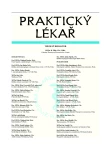Change in the number of stroke patients in the Czech Republic following an increase in the thrombolytic treatment window from 3 to 4.5 hours
Authors:
M. Hromová 1; Z. Janečková 1; G. Benadová 2
Authors‘ workplace:
Západočeská univerzita v Plzni
Fakulta zdravotnických studií
Katedra ošetřovatelství a porodní asistence
Vedoucí: Mgr. Lucie Kašová
1; Nemocnice na Homolce
Neurologie JIP
Primář: MUDr. Miroslav Kalina
2
Published in:
Prakt. Lék. 2010; 90(9): 542-544
Category:
Of different specialties
Overview
Cerebral vascular accidents (CVA) are one of the main causes of permanent disability and the third most common cause of death in the Czech Republic. The incidence and prevalence of CVA is relatively high and more recently it has an increasing tendency both in seniors and in people in productive age. There are approximately 35 000 attacks each year in the Czech Republic. One third of individuals dies within one year of an attack, one third survives with permanent or severe after-effects, and only one third survives without serious damage. CVA are the most common cause of disability in elderly patients. Therefore, treatment is aimed not only at a reduction of mortality but also at maintenance of patient’s self-sufficiency. The treatment of CVA is always individual. Therapy is selected based on the cause and type of CVA, and from associated extracerebral indicators:
– age,
– health state,
– scheme of therapeutical procedures,
– clinical neurological symptomatology,
– applied imaging methods (CT, MR, USG of carotid arteries, etc.).
All types of CVA are considered an emergency condition. Consequently, pre–hospital emergency care is regarded as an irreplaceable and integral part of treatment.
Key words:
cerebral vascular accidents, thrombolysis, ECASS 3 study.
Sources
1. Školoudík, D., Bar, M., Mikulík, R. a kol. Standard pro podání systémové trombolýzy pacientům s akutním mozkovým infarktem [on line]. Dostupné na: http://www.czech-neuro.cz/att/L/s/R/phpL sR6Iq.doc
2. Goldemund, D., Mikulík, R. Trombolytická terapie akutního mozkového infarktu. Neurológia pre pra, 2006, 6, s. 322-325.
3. Mikulík, R., Václavík, D., Sanák, D. et al. A nationwide study on topography and efficacy of the stroke treatment network in the Czech republic. J. Neurol. 2010, 257(1), p. 31-37.
4. Mlčoch, Z. Neurologie. Cévní mozkové příhody [on line]. Dostupné na http://www.zbynekmlcoch.cz /info/neurologie/index.php.
5. Kalvach, P. Mozkové ischémie a hemorhagie. Praha: Grada, 1997. ISBN 8071691097.
6. SITS (Safe Implementation of Treatments in Stroke) Register. https://sitsinternational.org/ - přístup pouze pro registrované uživatele.
7. Ticháček, M., Šeblová, J. Přednemocniční péče o pacienty s akutním mozkovým infarktem, indikovanými k trombolytické léčbě. Doporučený postup výboru ČLS JEP-společnosti UM a MK. Urgent. Med. 2009, 12, s. 34-35.
Labels
General practitioner for children and adolescents General practitioner for adultsArticle was published in
General Practitioner

2010 Issue 9
- What Effect Can Be Expected from Limosilactobacillus reuteri in Mucositis and Peri-Implantitis?
- Memantine Eases Daily Life for Patients and Caregivers
- Metamizole vs. Tramadol in Postoperative Analgesia
- Advances in the Treatment of Myasthenia Gravis on the Horizon
Most read in this issue
- Spondylodiscitis – known and unknown
- Preoperative treatment of a diabetic patient
- Nutritional assessment of hospitalized elderly people
- Shopping addiction as a problem
